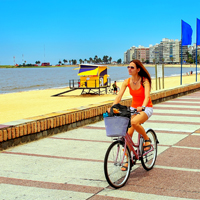Cost of Living in Cabo Polonio
Summary: If you're moving to Cabo Polonio, understanding the the cost of living in Cabo Polonio helps you know what to expect when it comes to apartment or house hunting, grocery shopping, transportation, dining out, utilities and more.
| Cost of Living | Cabo Polonio |
| Apartment Rentals | Rent for a one-bedroom apartment in the city center can range from $400 to $600 USD per month. Rent for a three-bedroom apartment in the city center can range from $800 to $1,200 USD per month. |
| Apartment Purchases | The cost of purchasing an apartment in Cabo Polonio can range from $50,000 to $100,000 USD, depending on the size and location. |
| Transportation | Public transportation in Cabo Polonio is limited, so most people rely on taxis or private vehicles. Taxi fares start at around $2 USD and can go up to $10 USD, depending on the distance. Private vehicles can cost anywhere from $10,000 to $20,000 USD. |
| Groceries | Basic groceries such as bread, milk, eggs, and vegetables can cost around $20 USD per week. Prices for imported items such as cheese, meat, and fish can be higher. |
| Restaurants | A meal at a mid-range restaurant in Cabo Polonio can cost around $15 USD per person. A three-course meal for two people at a high-end restaurant can cost around $50 USD. |
| Utilities | Utility bills such as electricity, water, and gas can cost around $50 USD per month. Internet and phone bills can cost around $30 USD per month. |
| Private School Tuition | Tuition for preschool can range from $200 to $400 USD per month. Tuition for elementary school can range from $400 to $800 USD per month. Tuition for middle school can range from $800 to $1,200 USD per month. Tuition for high school can range from $1,200 to $2,000 USD per month. |
Monthly Budget for Retirees in Cabo Polonio
"The cost of living in Cabo Polonio, is relatively low compared to many Western countries. The cost of housing is quite affordable, especially if you're renting. However, buying property can be more expensive due to the high demand and limited supply. Food and groceries are also reasonably priced, with local markets offering fresh produce at lower costs. Dining out is also inexpensive, with a meal at a mid-range restaurant being quite affordable. Public transportation is not available in Cabo Polonio, so there's no cost associated with it. However, if you own a vehicle, you'll need to consider the cost of fuel, which can be higher than in other countries. healthcare is generally affordable, especially if you're a resident and qualify for the public healthcare system. Overall, while the cost of living in Cabo Polonio is low, it's important to remember that it's a remote area with limited services and amenities," said one expat living in Cabo Polonio.
Can I live in Cabo Polonio on $1,500 a month?
"I've been living in Cabo Polonio for a while now, and I can tell you that it's definitely possible to live comfortably on $1,500 a month, but you'll have to make some sacrifices. Cabo Polonio is a small, remote village with limited modern amenities, so you'll have to adjust your expectations accordingly. For example, there's no running water or electricity in most of the village, so you'll have to rely on solar power and rainwater collection for your daily needs. As for housing, you'll find that most of the accommodations in Cabo Polonio are rustic and simple, but you can still find some comfortable options within your budget. I'd recommend looking for a place in the Barra de Valizas or Aguas Dulces neighborhoods, as they tend to be more affordable and still offer a decent quality of life. On the other hand, I'd avoid the more expensive neighborhoods like Punta del Diablo or La Pedrera, as they can be quite pricey and might not fit within your budget.In terms of food, you'll find that groceries are relatively affordable, but you'll have to get used to a more limited selection of products compared to what you might be used to in a more developed country. Eating out can be a bit more expensive, but there are still some affordable options if you stick to local, family-owned restaurants.One of the biggest sacrifices you'll have to make is in terms of entertainment and social life. Cabo Polonio is a small, isolated village, so there's not a lot of nightlife or cultural events happening. However, if you enjoy nature and outdoor activities, you'll find plenty to do, such as hiking, horseback riding, and exploring the beautiful beaches and sand dunes.Overall, living in Cabo Polonio on $1,500 a month is doable, but you'll have to be prepared to make some sacrifices and adjust your lifestyle to fit the unique environment of this remote Uruguayan village," commented an expat living in Cabo Polonio.
Can I live in Cabo Polonio on $3,500 a month?
"I've been living in Cabo Polonio for a while now, and I can tell you that it's definitely possible to live comfortably on $3,000 a month, but you'll have to make some sacrifices. Cabo Polonio is a small, remote village with limited modern amenities, so you'll have to adjust your expectations accordingly. For example, there's no running water or electricity in most of the village, so you'll have to rely on solar power and rainwater collection for your daily needs. Internet access is also limited, so you might have to travel to nearby towns for a reliable connection.In terms of housing, you'll find that most accommodations in Cabo Polonio are rustic and simple, but you can still find some comfortable options within your budget. I'd recommend looking for a place in the Barra de Valizas or Aguas Dulces neighborhoods, as they tend to be more affordable and still offer a decent quality of life. On the other hand, I'd avoid the more expensive neighborhoods like Punta del Diablo or La Pedrera, as they cater more to tourists and can be quite pricey.As for other expenses, you'll find that food and transportation costs are relatively low in Cabo Polonio. There's a small local market where you can buy fresh produce and other essentials, and you can also catch fish or forage for edible plants if you're feeling adventurous. Public transportation is limited, but you can easily get around on foot or by bike, which will save you money in the long run.Overall, living in Cabo Polonio on $3,000 a month is doable, but you'll have to be prepared to live a simpler, more rustic lifestyle than you might be used to. If you're willing to make those sacrifices, though, you'll find that the natural beauty and laid-back atmosphere of the village more than make up for any inconveniences," said one expat living in Cabo Polonio.
Can I live in Cabo Polonio on $5,000 a month?
"I've been living in Cabo Polonio for a while now, and I can tell you that it's definitely possible to live comfortably on $5,000 a month, even if you're used to modern amenities. However, there are some sacrifices you'll have to make to make it work. First of all, Cabo Polonio is a small, remote village with limited access to modern amenities. There's no electricity grid, so you'll have to rely on solar power or generators for electricity. Internet access is also limited, so you might have to adjust your expectations when it comes to staying connected. As for housing, there are a few affordable neighborhoods you can consider. The area around the lighthouse is quite popular, with a mix of locals and expats living there. It's close to the beach and has a nice community vibe. Another option is the area around the main street, which has a few shops and restaurants. It's a bit more lively and might be a good fit if you're looking for a more social atmosphere. On the other hand, there are some more expensive neighborhoods that you might want to avoid if you're trying to stick to your budget. The beachfront properties, for example, can be quite pricey, especially during the high season. Additionally, some of the more secluded areas in the village can also be more expensive, as they offer more privacy and larger plots of land. In terms of transportation, you'll have to get used to the fact that there are no cars in Cabo Polonio. The village is only accessible by 4x4 vehicles or on foot, so you'll have to rely on walking or horseback riding to get around. This might be a bit of an adjustment, but it's also part of the charm of living in such a unique place. Overall, living in Cabo Polonio on $5,000 a month is definitely doable, but you'll have to be prepared to make some sacrifices and adjust your lifestyle. The natural beauty and laid-back atmosphere of the village make it a truly special place to live, and I think you'll find that the trade-offs are well worth it," commented an expat living in Cabo Polonio.
About the Author
 Betsy Burlingame is the Founder and President of Expat Exchange and is one of the Founders of Digital Nomad Exchange. She launched Expat Exchange in 1997 as her Master's thesis project at NYU. Prior to Expat Exchange, Betsy worked at AT&T in International
and Mass Market Marketing. She graduated from Ohio Wesleyan University
with a BA in International Business and German.
Betsy Burlingame is the Founder and President of Expat Exchange and is one of the Founders of Digital Nomad Exchange. She launched Expat Exchange in 1997 as her Master's thesis project at NYU. Prior to Expat Exchange, Betsy worked at AT&T in International
and Mass Market Marketing. She graduated from Ohio Wesleyan University
with a BA in International Business and German.
Some of Betsy's articles include 12 Best Places to Live in Portugal, 7 Best Places to Live in Panama and 12 Things to Know Before Moving to the Dominican Republic. Betsy loves to travel and spend time with her family. Connect with Betsy on LinkedIn.



